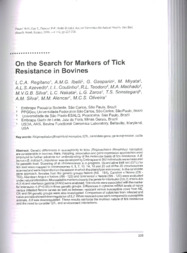On the search for markers of tick resistance in bovines.
On the search for markers of tick resistance in bovines.
Author(s): REGITANO, L. C. de A.; IBELLI, A. M.; GASPARIN, G.; MIYATA, M.; AZEVEDO, A. L. S.; COUTINHO, L. L.; TEODORO, R. L.; MACHADO, M. A.; SILVA, M. V. G. B.; NAKATA, L. C.; ZAROS, L. G.; SONSTEGARD, T. S.; SILVA, A. M.; ALENCAR, M. M. de; OLIVEIRA, M. C. de S.
Summary: Genetic differences in susceptibility to ticks (Rhipicephalus (Boophilus) microplus) are considerable in bovines. Here, mapping, association and gene expression approaches were employed to further advance our understanding of the molecular basis of tick resistance. A B. taurus x B. indicus F2 population was developed by Embrapa and 382 individuals were measured for parasitic load. Scanning of all chromosomes is in progress. Quantitative trait loci (QTL) for tick load were mapped to chromosomes 4, 5, 7, 10, 14, 18 and 23 out of the 20 chromosomes scanned and were dependent on the season in which the phenotype was scored. In the candidate gene approach, females from the genetic groups Nelore (NE - 184), Canchim × Nelore (CN -153), Aberdeen Angus × Nelore (AN - 123) and Simmental × Nelore (SN - 120) were evaluated under natural infestation. Microsatellite markers close to the genes for interleukin 2 (IL2), interleukin 4 (IL4) and interferon gamma (IFNG) were analysed. Tick counts were associated with the marker for interleukin 4 (P<0.05) in three genetic groups. Differences in cytokine mRNA levels of nai?ve versus infested Nelore calves as well as between resistant versus susceptible cows from NE, CN and AN genetic groups were also investigated. Comparison of cytokines from infested and naive animals showed downregulation of IL2. When resistant cows were compared to susceptible animals, IL8 was downregulated. These results reinforce the multiloci nature of tick resistance and the need to consider QTL and environment interactions.
Publication year: 2008
Types of publication: Journal article
Keywords: Carrapato, Estudos, Marcadores, Resistência
Observation
Some of Embrapa's publications are published as ePub files. To read them, use or download one of the following free software options to your computer or mobile device. Android: Google Play Books; IOS: iBooks; Windows and Linux: Calibre.
Access other publications
Access the Agricultural Research Database (BDPA) to consult Embrapa's full library collection and records.
Visit Embrapa Bookstore to purchase books and other publications sold by Embrapa.

